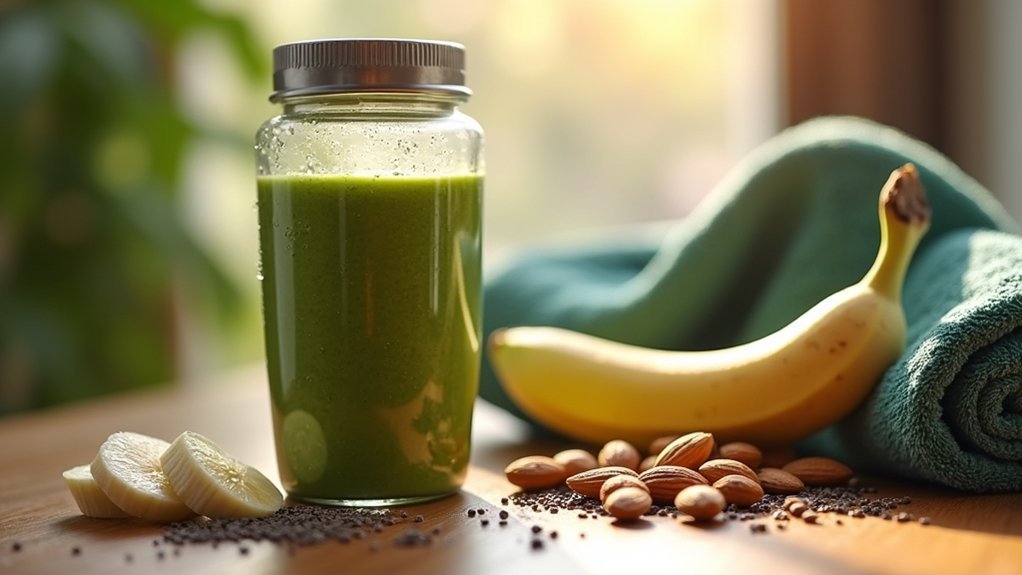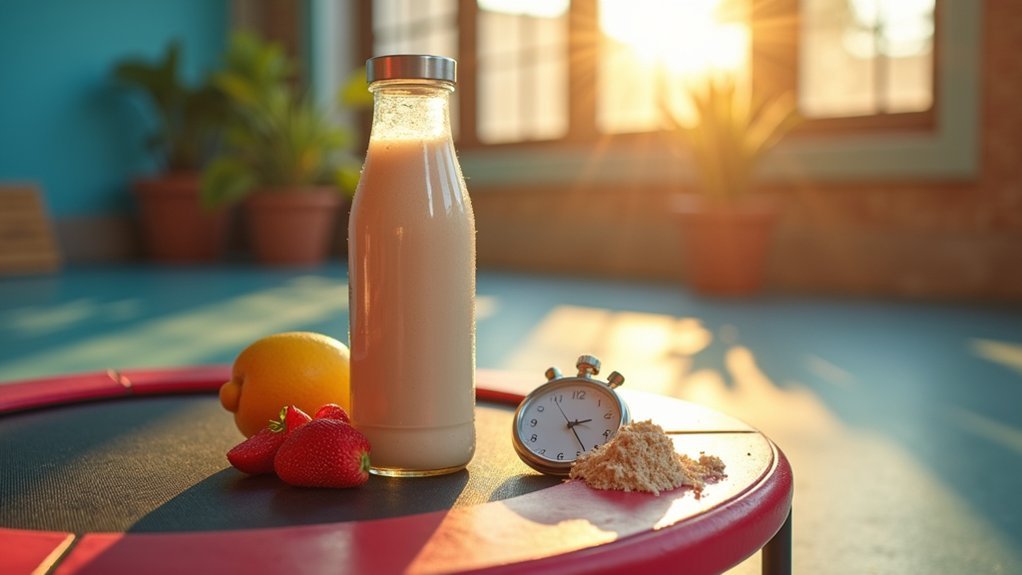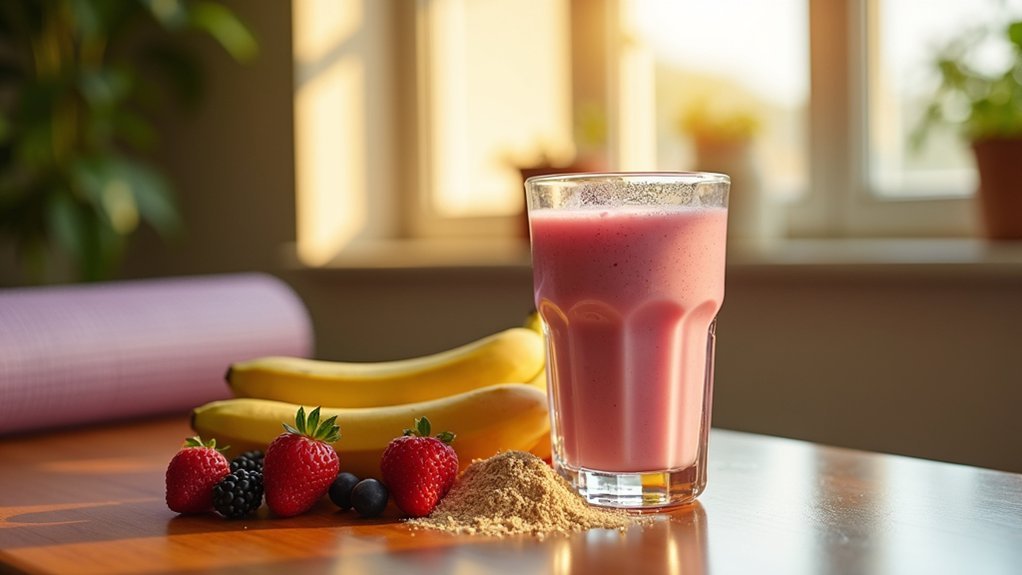The perfect protein dose after exercise is 20-25 grams (about 0.4-0.5g/kg of lean body mass), consumed within 1-2 hours post-workout. You don’t need to rush—this recovery window is more flexible than previously thought. Pre-workout protein intake can reduce your immediate post-exercise needs. While timing matters, your total daily protein consumption (1.4-1.6g/kg for active individuals) plays an even more essential role in recovery. The following guide explores how to optimize your protein strategy for maximum results.
What’s the Perfect Protein Dose After Exercise?

How much protein should you consume after your workout? Research points to 20-25 grams as the sweet spot for effectively stimulating muscle growth and protein synthesis. This translates to roughly 0.4-0.5 grams per kilogram of lean body mass for most people.
Timing matters too, but it’s more flexible than previously thought. While consuming protein within 1-2 hours post-exercise is commonly recommended, the “anabolic window” isn’t as rigid as once believed.
If you’ve had protein before your workout, the immediate post-exercise need may be reduced. These pre-workout meals can effectively provide amino acids needed for muscle repair.
Your individual needs might vary based on body composition, exercise intensity, and how much muscle mass was activated during your session.
For best recovery, consider pairing your protein with 40-60 grams of carbohydrates.
The Science Behind Protein Needs After Rebounding Workouts
You’ve likely heard about the critical “30-minute protein window” after exercise, but research now shows this recovery period extends several hours post-workout.
For rebounding specifically, your protein needs fall between 1.0-1.6g/kg of body weight daily, lower than what’s required for intense strength training.
While timing isn’t as urgent as once thought, consuming some protein after your trampoline session still supports ideal muscle recovery and helps maintain lean muscle mass. Including a source rich in essential amino acids, particularly leucine, can maximize the muscle protein synthesis response to your rebounding workout.
Recovery Window Myth
Despite being widely promoted in fitness circles for decades, the concept of a narrow 30-minute “anabolic window” after exercise has increasingly come under scientific scrutiny.
Recent research challenges this restrictive timeframe, suggesting your body remains receptive to protein for much longer than previously thought. A 2013 meta-analysis indicates an effective window spanning four to six hours before or after your workout. Studies show that protein synthesis rates remain elevated for 24-48 hours following resistance exercise, giving you more flexibility with nutrient timing.
What matters more is your total daily protein consumption rather than precise timing. Your body’s anabolic response depends on various factors including age, hormonal status, and training intensity—not just when you consume protein.
Instead of rushing to mix your protein shake immediately after exercise, focus on consistent protein intake throughout the day and ensuring adequate nutrition within a broader post-workout timeframe.
Rebounding Protein Requirements
While rebounding workouts differ from traditional resistance training, they create similar demands on your muscles that require adequate protein for recovery.
Though specific research on rebounding is limited, you can follow guidelines similar to resistance training—aim for 20-25 grams of high-quality protein post-workout.
Rebounding combines both resistance and cardiovascular elements, engaging lower body muscles with less impact than running.
For best results, consume protein within the recovery window and continue with protein-rich meals every 3-4 hours throughout the day. This approach helps maintain elevated muscle protein synthesis rates since a single exercise session can enhance muscle protein balance for up to 48 hours.
Your overall daily protein intake should fall between 1.2-1.6 grams per kilogram of body weight.
Prioritize complete proteins like whey, casein, or whole food sources that contain essential amino acids, and don’t forget to balance your intake with carbohydrates and proper hydration.
Timing Your Protein Intake for Maximum Trampoline Recovery

You’ll maximize muscle recovery by consuming 20-40g of protein within two hours after your trampoline workout, though this window extends to 5-6 hours if you’ve eaten before training.
Protein quality matters greatly—whey offers quicker absorption than plant proteins, though complete vegan options like soy can effectively support recovery with slightly larger portions.
While timing creates advantages for fasted morning rebounders, your consistent daily protein intake (1.6-2.2g/kg) ultimately drives long-term progress more than perfect post-workout timing. Recent research shows evening exercise may enhance the benefits of immediate post-workout protein consumption for aerobic adaptations and recovery.
Optimizing Recovery Windows
Although perfect timing isn’t the sole factor in protein effectiveness, understanding recovery windows can greatly enhance your post-trampoline recovery outcomes.
Rather than obsessing over the traditional “anabolic window,” recognize that your body remains receptive to protein for up to 24 hours after exercise.
For trampoline workouts specifically, the eccentric stress and metabolic demand create unique recovery needs.
Aim for 20-25g of protein within the first hour post-exercise, paired with 40-60g of carbohydrates to jumpstart glycogen restoration. Women in particular may need to be more strategic with this timing due to their shorter recovery window compared to men.
If you train multiple times daily, space protein intake every 3-4 hours to maximize muscle protein synthesis.
Plant vs. Animal Proteins
When choosing between plant and animal proteins for post-trampoline recovery, understanding their fundamental differences can greatly impact your results. Animal proteins typically offer a more complete amino acid profile and higher leucine content, triggering muscle protein synthesis more efficiently. For optimal muscle protein synthesis after trampoline workouts, a protein dose of 20-25 grams is recommended based on scientific research.
| Protein Type | Recovery Benefits | Best Timing |
|---|---|---|
| Whey (Animal) | Rapid absorption, high leucine | Immediately post-workout |
| Casein (Animal) | Slow-release, sustained recovery | Before sleep or long breaks |
| Soy (Plant) | Complete amino acid profile | Within 1-2 hours post-exercise |
If you’re plant-based, combine protein sources like pea and rice to create a complete amino acid profile. While animal proteins may have a slight edge in efficiency, properly formulated plant proteins can provide comparable recovery benefits when consumed in appropriate amounts.
Timing vs. Consistency
Beyond selecting the right protein source, many trampoline enthusiasts wonder about the perfect moment to consume protein for recovery.
While conventional wisdom suggests consuming protein immediately after your session is critical, recent research paints a more nuanced picture.
Total daily protein intake actually matters more than perfect timing. Instead of stressing about the post-workout “anabolic window,” focus on consistently hitting your overall protein targets throughout the day.
That said, consuming 20-25g of protein within an hour post-trampoline workout isn’t harmful—it’s simply one piece of your nutritional strategy. For active individuals, daily protein recommendations range from 1.4-1.6 g/kg/day to support recovery and training adaptations.
Your body can benefit from protein supplementation up to 24 hours after exercise. For practical recovery, pair your protein with 40-60g of carbohydrates, and distribute protein intake across multiple daily meals rather than concentrating solely on post-workout consumption.
Calculating Your Personal Protein Requirements for Rebounding

Since your body’s protein needs vary based on several factors, determining your personal protein requirements after exercise is essential for peak recovery and muscle development.
Start by multiplying your weight in kilograms by 1.2-2.0g, with athletes needing the higher end of this range.
For optimal post-workout nutrition, aim for 15-25g of protein within two hours of exercise, with 3g of leucine (abundant in whey protein) to trigger muscle synthesis.
Consider the intensity and type of your workout—more strenuous activities demand more protein. Consistency is key, as regular protein intake throughout the day supports optimal muscle recovery and growth.
Divide your daily protein into four meals containing 0.25-0.5g/kg each, and don’t forget to adjust your intake based on your goals, whether you’re building muscle or focusing on recovery.
Best Protein Sources to Fuel Post-Trampoline Muscle Repair
After an intense trampoline workout depletes your muscles’ energy stores, choosing the right protein sources becomes essential for optimal recovery. Your body craves complete proteins that deliver all essential amino acids for ideal muscle repair. Research recommends consuming 20 to 40 grams of protein every few hours for optimal recovery benefits.
Animal sources like whey protein, eggs, and Greek yogurt offer rapid absorption when you need immediate recovery. For plant-based options, tempeh, lentils, and pea protein isolate provide comparable benefits.
Consider these strategic protein pairings:
- Greek yogurt with berries (15-20g protein plus inflammation-fighting antioxidants)
- Salmon with sweet potato (20g protein combined with glycogen-replenishing carbs)
- Egg scramble with spinach (18g protein plus iron and vitamin C for enhanced absorption)
Timing matters too—aim to consume protein within two hours post-workout for maximum muscle protein synthesis.
Balancing Carbs and Protein After High-Intensity Rebounding
When you complete a high-intensity rebounding session, your body immediately begins seeking both carbohydrates and protein to jumpstart recovery. Your glycogen-depleted muscles need replenishment, making the 30-60 minute post-workout window essential for nutrient intake.
For ideal recovery, aim for a 3:1 or 4:1 carb-to-protein ratio after moderate to high-intensity rebounding. This typically translates to consuming 1.2 g/kg/hr of carbohydrates paired with 0.3-0.4 g/kg/hr of protein within the first hour. High-glycemic carbs work best for quick glycogen restoration between sessions. Remember that these recommendations should be tailored to your body as individual metabolic efficiency significantly affects how you process and utilize different macronutrient ratios.
Your specific needs may vary based on workout intensity and duration. Longer, more intense rebounding sessions demand higher carbohydrate intake, while strength-focused workouts might benefit from a more balanced 2:1 ratio to support muscle repair.
How Body Weight Affects Your Post-Rebounding Protein Needs
Your body weight plays an essential role in determining exactly how much protein you need after rebounding exercises.
The science shows heavier individuals require more total protein, even when following the same gram-per-kilogram recommendations as lighter athletes.
For ideal recovery, follow these body weight-adjusted guidelines:
- Lighter athletes (60kg): Aim for 96-120g daily protein spread across 3-4 meals of 25-30g each
- Mid-range athletes (75kg): Consume 120-150g daily, dividing into 4-5 meals of 25-30g
- Heavier athletes (90kg+): Target 144-180g daily protein through 4-6 meals containing 30-40g each
Research supports that resistance exercise combined with adequate protein is absolutely essential for maximizing muscle maintenance and growth, with recommendations of 1.6-2.2 g/kg/day for optimal results.
Morning vs. Evening Rebounding: Adjusting Your Protein Strategy
Your rebounding workouts trigger different hormonal responses in the morning versus evening, requiring strategic protein timing adjustments to maximize benefits.
While morning sessions pair well with protein-rich breakfasts that reverse overnight catabolism, evening rebounding benefits from pre-sleep protein supplementation—particularly slow-digesting casein—to support overnight recovery when your body enters its prime repair state.
You’ll need to supplement differently depending on your workout time: morning rebounders should prioritize leucine-rich proteins immediately after exercise, while evening exercisers should focus on a substantial pre-sleep protein dose of about 40g to fuel overnight muscle synthesis. Research indicates that consuming protein within the anabolic window after activity optimizes nutrient absorption and enhances recovery potential.
Hormone Optimization Times
Training at different times of day triggers unique hormonal responses that can greatly impact protein utilization and muscle growth. Your body’s cortisol peaks in the morning, potentially increasing muscle breakdown, while testosterone levels naturally surge in the AM hours despite exercise-induced spikes occurring anytime.
To maximize your hormonal environment for muscle growth:
- Morning workouts: Combat elevated cortisol with 20-30g protein immediately after training, paired with carbohydrates to enhance insulin sensitivity and glycogen replenishment. Research shows that consuming protein at breakfast helps stimulate muscle protein synthesis and prevents the catabolic state that occurs overnight.
- Evening sessions: Leverage the extended recovery window with 30-40g casein before sleep, which increases amino acid incorporation by 76% when following resistance training.
- Anytime strategy: Maintain 15-25g protein feedings every 3 hours throughout the day, regardless of when you train.
Night Recovery Differences
When the body recovers from exercise, timing creates distinct opportunities for protein utilization based on whether you trained in the morning or evening.
Morning workouts following overnight fasting benefit from immediate protein intake (within 2 hours) to jumpstart recovery.
Combine this with carbohydrates to replenish depleted glycogen stores.
Evening sessions offer a unique advantage – proximity to sleep allows you to leverage your body’s natural overnight recovery processes. Studies show the anabolic window extends longer than previously thought, making evening workouts particularly effective for maximizing recovery potential.
Consider consuming 20-40g of slow-digesting casein before bed to maximize this window.
Regardless of timing, your total daily protein intake (1.6-2.2g/kg) remains the primary driver of results.
Distribute 3-4 equal protein doses throughout your day, focusing on whole foods when practical, and you’ll optimize recovery regardless of when you train.
When to Supplement
The timing of protein supplements strategically complements your whole-food nutrition plan based on when you train. Your body’s protein needs fluctuate throughout the day, requiring adjustments to maximize muscle synthesis and recovery.
If you exercise in the morning, front-load your protein intake immediately after training to kickstart muscle protein synthesis after the overnight fast. For evening workouts, make sure you consume protein both post-workout and before bed to support overnight recovery. Recent research indicates that total daily intake matters more than precise timing for resistance-trained individuals seeking muscle growth.
For best results:
- Morning strategy – Consume 30g of fast-digesting protein upon waking to provide essential leucine and halt overnight muscle breakdown.
- Post-workout window – Take 20-30g within 15-60 minutes after exercise to capitalize on the anabolic window.
- Evening recovery – Use slower-digesting casein protein (40g) before bed for sustained amino acid release during sleep.
Plant-Based Protein Options for Trampoline Enthusiasts
As trampoline workouts demand explosive power and sustained endurance, your post-session nutrition becomes essential for ideal recovery.
Plant-based athletes can enhance muscle repair with complete protein sources like tofu (13g/100g), tempeh (21g/100g), or quinoa (8g per cup).
Plant-based protein powerhouses fuel optimal recovery, delivering essential amino acids when your muscles need them most.
For maximum recovery benefits, try strategic meal combinations—a tempeh stir-fry with broccoli delivers 30g+ protein per serving, while a quinoa-black bean bowl provides complementary amino acids.
Seitan offers an impressive 25g protein per 3.5oz serving, making it excellent for serious muscle repair.
Don’t overlook performance-boosting nutrients: pair legumes with vitamin C sources to enhance iron absorption, and include hemp or chia seeds for their anti-inflammatory properties that reduce exercise-induced stress.
For ideal leucine intake, prioritize soy products to support muscle protein synthesis.
Research indicates that consuming 1.6 g/kg body weight is the minimum threshold for optimal muscle gains, regardless of whether protein comes from plant or animal sources.
The Extended Recovery Window: When to Consume Protein After Bouncing
Contrary to popular belief, your protein consumption timing doesn’t require split-second precision after dismounting the trampoline.
Research shows muscle protein synthesis remains elevated for hours following your bouncing session, giving you a much wider recovery window than previously thought.
Your post-trampoline protein strategy can be flexible while still maximizing results:
- Consume protein either before or immediately after your session if convenient, but don’t stress if there’s a delay.
- Plan to eat protein-rich meals every 5-6 hours throughout the day to maintain elevated synthesis rates.
- Consider pre-sleep protein intake after evening trampoline workouts to support overnight recovery.
Remember that consistency in your overall protein intake matters more than obsessing over exact post-workout timing. Aim for approximately 1 to 1.4 grams of protein per pound of lean body mass daily to support muscle recovery and growth.
Frequently Asked Questions
Does Protein Timing Impact Weight Loss During Rebounding Training?
Yes, protein timing can support your weight loss during rebounding training by helping you maintain muscle mass, increase satiety, and improve recovery while in caloric deficit. It’s a helpful but not essential strategy.
Can Excessive Protein Intake Harm Recovery After Trampoline Workouts?
Yes, excessive protein intake can hinder your recovery by causing digestive discomfort, imbalanced nutrients, and potentially replacing needed carbohydrates that replenish energy stores after your high-intensity trampoline workouts. Aim for 15-30g instead.
How Do Hormones Affect Protein Utilization After Rebounding Exercise?
After rebounding exercise, your body’s hormones regulate protein use. Insulin helps amino acid uptake, while exercise-induced GH and testosterone enhance synthesis. You’ll metabolize protein better with carbs, which reduces cortisol’s catabolic effects.
Should Protein Intake Differ Between Competitive and Recreational Bouncers?
Yes, your protein intake should differ based on your bouncing level. As a competitive bouncer, you’ll need 1.6-2.0g/kg/day with 30-40g post-workout. Recreational bouncers can aim for 1.1-1.4g/kg/day with 20-30g post-exercise doses.
Are Liquid Proteins Better Than Solid Forms After Trampoline Sessions?
Liquid proteins can offer faster absorption after trampoline sessions, especially hydrolyzed forms. You’ll likely find them more convenient and easier on your stomach during high-impact recovery, though solid forms provide similar overall benefits.
In Summary
The perfect post-rebounding protein intake isn’t one-size-fits-all. You’ll need approximately 0.25-0.3g per kg of body weight (about 20-40g for most people) within the 2-hour recovery window. Consider your workout intensity, body size, and dietary preferences when choosing your protein source. Whether you’re bouncing at dawn or dusk, timed protein consumption will optimize your muscle recovery and enhance your rebounding performance.





Leave a Reply